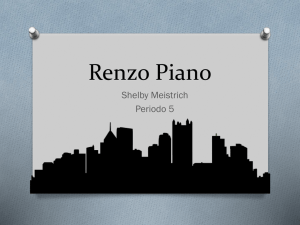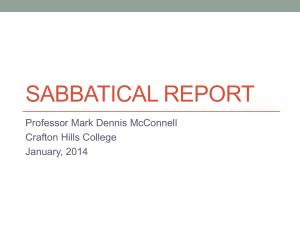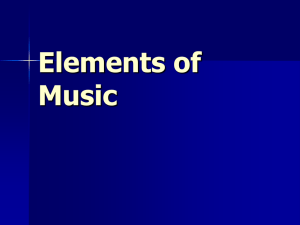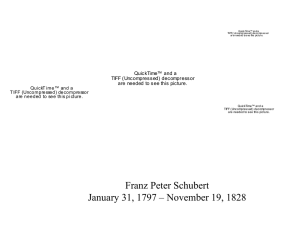HOW TO MAKE A PIANO SING
advertisement
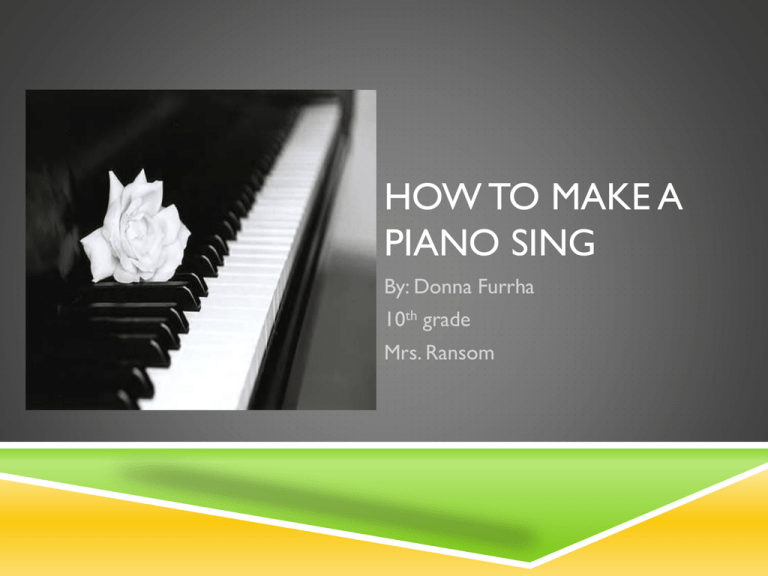
HOW TO MAKE A PIANO SING By: Donna Furrha 10th grade Mrs. Ransom PURPOSE/PROBLEM Have you ever been to the store with your mom and dad and accidently ran into a piano? I have, I love playing new instruments; I enjoy the beats that come right out of my head without any instructions given by anyone that happen naturally. So I want to know how the piano can sing, I want to know how to play each key and start to make my own beat. I want to learn how to make my own beat because one day I want to become famous. I want to teach everyone else who doesn’t know how to play the piano also! HYPOTHESIS If I look at the difference of each key, then the octave will change. As I play, I will learn new beats from each key and so will you! I think that each key has a different tone that is released from it depending on the change of air pressure. The sound is produced by vibrations of objects. So if I have a Electric piano and set it on a table It will have more vibration because its being set on a simple object and the piano has more power coming from itself. MANIPULATED OR INDEPENDENT VARIABLE The Piano keys are my manipulated variable, it is being changed by a variety of sounds. RESPONDING OR DEPENDENT VARIABLE The dependent variable consists of using the same Piano throughout the experiment. CONSTANTS I will be doing my experiment bright and early around 9’oclock. The room is as hot as a fire pit. The weather is slightly chilly and if you take a look outside, the snow slowly releases from the clouds. The power point is up and ready to go – so the room is dark so the screen is visible. Students glare as I present, I stand there- everything is nerve wrecking only striving for the best. CONTROL The Control Group I compared it to was other types of pianos. A kids piano had no comparison to a professional piano. MATERIALS LIST A quiet room with a piano Stopwatch or watch with second hand Helper to assist with timing PROCEDURE STEPS Start by holding the C2(two octaves below middle C) string open. Depress the key very slowly so that the damper is lifted up, but the hammer does not cause the string to vibrate. There should be no sound. If you do hear sound, let go of the key, wait a second or two, and try again. While still holding C2 open, firmly play and quickly release C3(one octave below middle C). If you’re familiar with music terminology, you want to play a forte staccato note. RESULTS My results are that I found that the keys C1, D2, are much higher than D6. D6 is on the right side of the piano and much deeper. C1 is on the left side and the highest pitch, and D2 is on the middle left and a little lower than C1 but higher than D6 CONCLUSION In Conclusion, my hypothesis was correct. The longer I hold each key the more vibrations of the sound releases from it. The octave goes lower the further down I go. BIBLIOGRAPHY The Vladimir Horowitz quote in the project description on the Physics home page is from the liner notes to the CD collection, The Magic of Horowitz, Hamburg, Germany: Deutsche Grammophon GmbH, 1989. Henderson, T., 2004. "Lesson 5: Musical Instruments: Resonance," The Physics Classroom [accessed March 27, 2006] http://www.glenbrook.k12.il.us/GBSSCI/PHYS/CLASS/sound/u11l5a.html . Irvine, T., 2000. "An Introduction to Music Theory," VibrationData.com Piano Page [accessed March 27, 2006] http://www.vibrationdata.com/piano.htm. http://www.sciencebuddies.org/science-fairprojects/project_ideas/Music_p012.shtml
